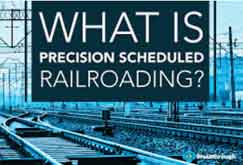The late Hunter Harrison brought so-called precision railroading the North America, as CEO of both Canadian National Railway and Canadian Pacific Railway and then later CSX.
It's a technique designed to both produce operational efficiencies and improve service to freight customers, though some critics say it's far more about railroad profits than it is serving customers.
Supply Chain Digest Says... |
|
|
After Harrison passed away while CEO of CSX, roughly halfway through the implementation of his precision railroading vision, new CEO Jim Foote vowed the company would continue the strategy. Rival Union Pacific then announced its plans to implement precision railroading concepts.
Is it working?
Depends on how you look at it.
Service has markedly improved at CSX, CEO Foote says.
And Union Pacific CEO Lance Fritz tells the Wall Street Journal that it has reduced dwell time at terminals and improved its on-time performance.
But for a variety of reasons, that isn't resulting in a move away from truck freight carriage to rail.
"We have to undo decades of bad service and experience," Foote said in an interview with the Journal, referencing not only CSX but the railroads as a whole.
Rail transport costs can be 15-20% lower that trucking. But that gap is a bit smaller now, with a weak freight environment and low spot market rates.
"Not only can you get a truck anytime you want it, but it's a very competitive price," Union Pacific's Fritz also told the Wall Street Journal, adding that "The wins that are occurring are being overwhelmed by macroeconomics" of the current trucking environment.
Union Pacific has also recently added a tool that notifies shippers when their rail cars have arrived, the type of info available for a long time in trucking.
Rail volumes in the US are down 4.1% thus far from a year ago, but that is probably more reflective of a soft overall freight market versus a loss of volume to trucking. The issue is more how if at all railroads can grab share from trucking.
.(See More Below)
|
CATEGORY SPONSOR: SOFTEON |
|
|
| |
|
|
The American Trucking Association's own forecast released in August shows trucking losing a couple of points of total freight share by 2030, some of that to rail intermodal, where containers are moved long distances on rail but with support from trucking on both sides of the move.
One expert, railroad career economist Jim Blaze, thinks the rail carrier's focus on profitability first is in part why they are gaining share from trucking.
 Writing in American Shipper, he notes that not long ago railroads were expecting and often getting near-double digit intermodal year-over-year volume gains, and fully expected to take market share from highway truckers. Writing in American Shipper, he notes that not long ago railroads were expecting and often getting near-double digit intermodal year-over-year volume gains, and fully expected to take market share from highway truckers.
But the allure of cost cutting took over the rail carriers. Intermodal origin/destination pairs have been cut by the current by railroads implementing precision railroading, Blaze says.
"They appear increasingly willing to manage for yield instead of growth," he says, adding "Statistically, it now appears that highway truck share of freight is growing."
He concludes by noting precision railroading is indeed reducing carrier costs, "But capturing more shippers and share of freight from trucking through precision railroading is, at best, a work in progress. Train schedules and final deliveries of rail carloads to shipper docks are still woefully imprecise."
The one angle left out of all this is CO2 emissions, which are much lower for rail per freight mile. Could that soon be a trigger that does move freight in rail's direction?
What do you think rail carriers need to do to increase market share of freight? Let us know your thoughts at the Feedback section below.
Your Comments/Feedback
|